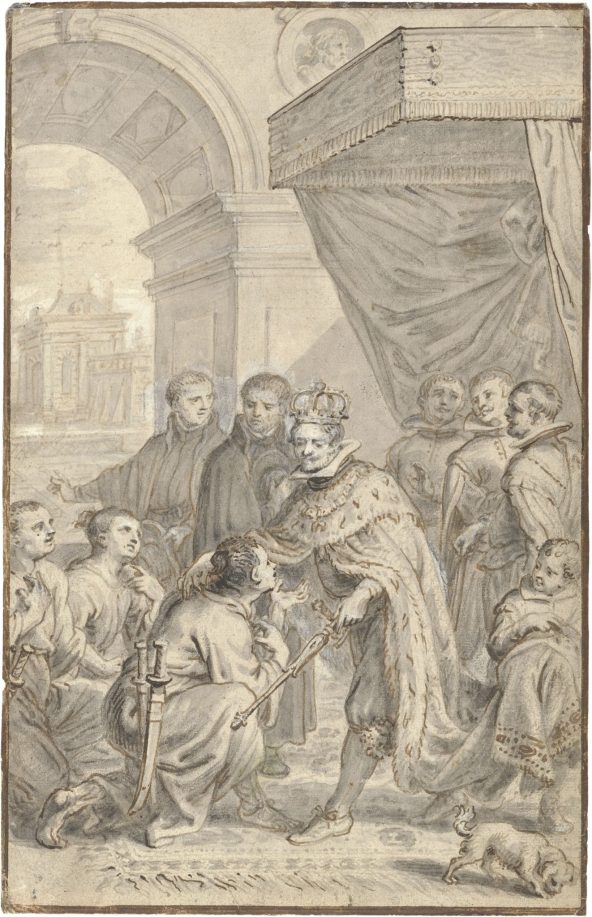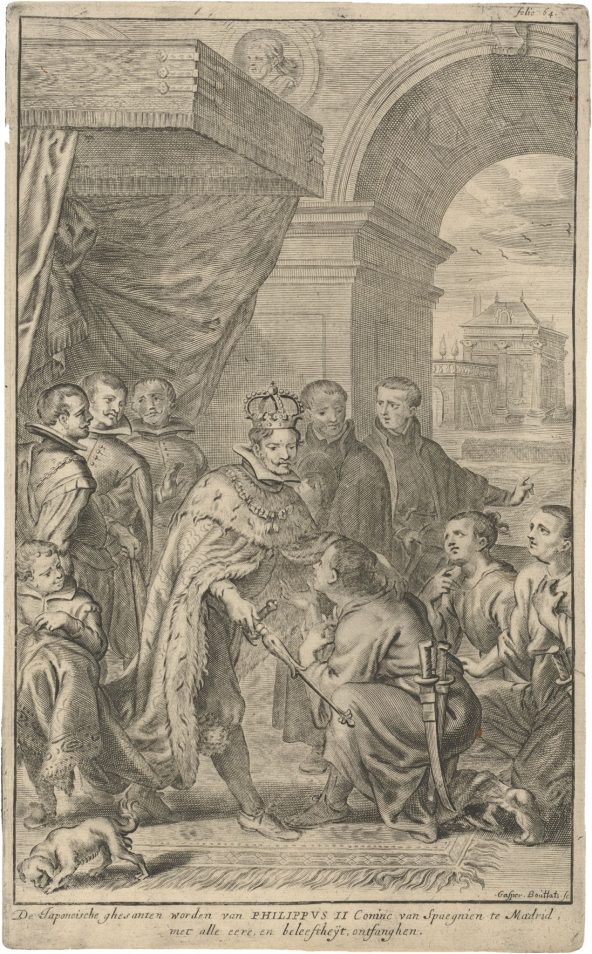Article: Japanese Emissaries in Sixteenth-Century Europe
Focus on the Peck Feature
In 1585, a delegation of four Christian Japanese boys from the island of Kyushu, known as The Boys’ Embassy of the Tenshō Period, arrived in Europe to meet some of the most important political and religious figures of the period, chief among them King Philip II of Spain and popes Gregory XIII and Sixtus V. Eighty years after this historic event, Flemish painter Abraham van Diepenbeeck created a drawing of the encounter between The Boys’ Embassy and King Phillip II of Spain. This Focus on the Peck Collection installation presents Van Diepenbeeck’s drawing alongside the engraving based on it, published in the 1667 book Kerckelycke historie van de gheheele wereldt (The Ecclesiastical History of the Whole World).
The Jesuit order of the Roman Catholic Church reached Japan in 1549 and converted thousands of people to Christianity within a short period. In 1585, a delegation of four Christian Japanese boys from the island of Kyushu arrived in Europe to meet some of the most important political and religious figures of the period, chief among them King Philip II of Spain and popes Gregory XIII and Sixtus V. Known as The Boys’ Embassy of the Tenshō Period, the voyage’s purpose was threefold: to demonstrate the Jesuits’ achievements in Japan, to secure continued financial backing for their mission, and to impress the Japanese visitors with the sights of Europe (for the future benefit of Christianity in Japan). Originally intended as a modest visit, it quickly became a grand affair. The boys were treated as distinguished visitors, honored with banquets and festivals in Portugal, Spain, and Italy, which attracted widespread attention among Europeans beyond the interests of the Church.
Eighty years after this historic event, Flemish painter Abraham van Diepenbeeck created a drawing of a specific aspect of the trip — the encounter between The Boys’ Embassy and King Phillip II of Spain. This Focus on the Peck Collection installation presents Van Diepenbeeck’s drawing alongside the engraving based on it, published in the 1667 book known in English as The Ecclesiastical History of the Whole World. Dedicated to the history of the Church’s missionary activities, the richly illustrated book became a standard resource for many Europeans to learn about distant cultures, including Japan.
Abraham van Diepenbeeck, King Phillip II of Spain Receiving the Japanese Delegation in Madrid, c. 1667

Abraham van Diepenbeeck, Flemish, 1596 – 1675, King Phillip II of Spain Receiving the Japanese Delegation in Madrid, c. 1667, black chalk, gray and brown washes with white highlights on paper, The Peck Collection, 2017.1.121.
See King Phillip II of Spain Receiving the Japanese Delegation in Madrid in more detail here.
In addition to his work as a painter, Abraham van Diepenbeeck produced over 750 drawings for engravings throughout his career. Here he illustrates the 1585 arrival of The Boys’ Embassy of the Tenshō Period in Madrid to meet King Philip II of Spain. Set in a grand architectural setting, three boys kneel before the king who stands among religious and court officials. While the artist has distinguished the boys as Japanese by their hairstyles and swords, he depicted their facial features with an idealized western appearance.
In his later drawings, Van Diepenbeeck employed a combination of black chalk, pen and ink, and variations of brown and gray wash applied in layers. He also included highlights and corrections in opaque white, seen here especially in Philip II’s face and behind the figures’ heads directly to his left.
Frederik Bouttats the younger, after Abraham van Diepenbeeck, King Phillip II of Spain Receiving the Japanese Delegation in Madrid, 1667

Frederik Bouttats the younger, after Abraham van Diepenbeeck, Flemish, died 1676, King Phillip II of Spain Receiving the Japanese Delegation in Madrid, 1667, engraving on paper, The Peck Collection, 2017.1.133.
Frederik Bouttats’ engraving after Abraham van Diepenbeeck’s drawing appears in reverse due to the printing process. It was one of many produced by Van Diepenbeeck and others for the first volume of Cornelis Hazart’s The Ecclesiastical History of the Whole World, published in Antwerp in 1667. The last book to include Van Diepenbeeck’s designs, it provided social, political, and religious information about various places around the world, with a specific emphasis on Jesuit missionary activities. The nearly 500-page work included reports about Asia, South America, and North America.
At the time of the book’s publication, Jesuits had already been expelled from Japan. Although they were initially welcomed there and several important daimyō, or feudal lords, embraced the new religion, in 1614 the Tokugawa military government outlawed Christianity until 1873, when it was made legal again.
